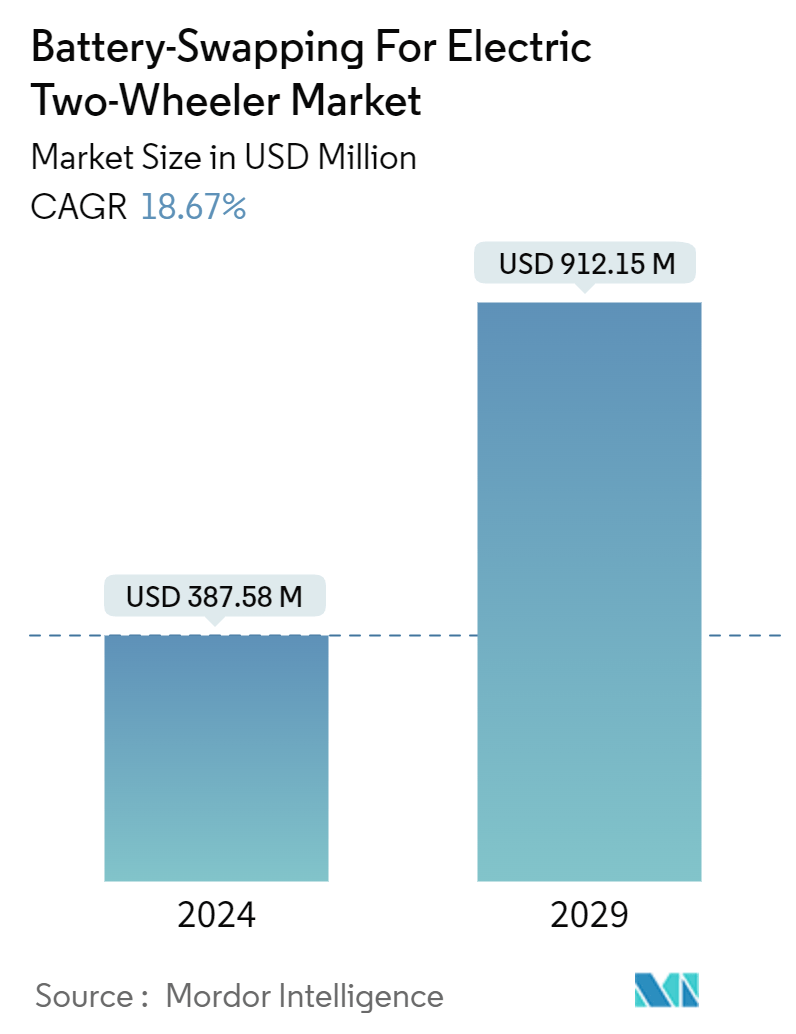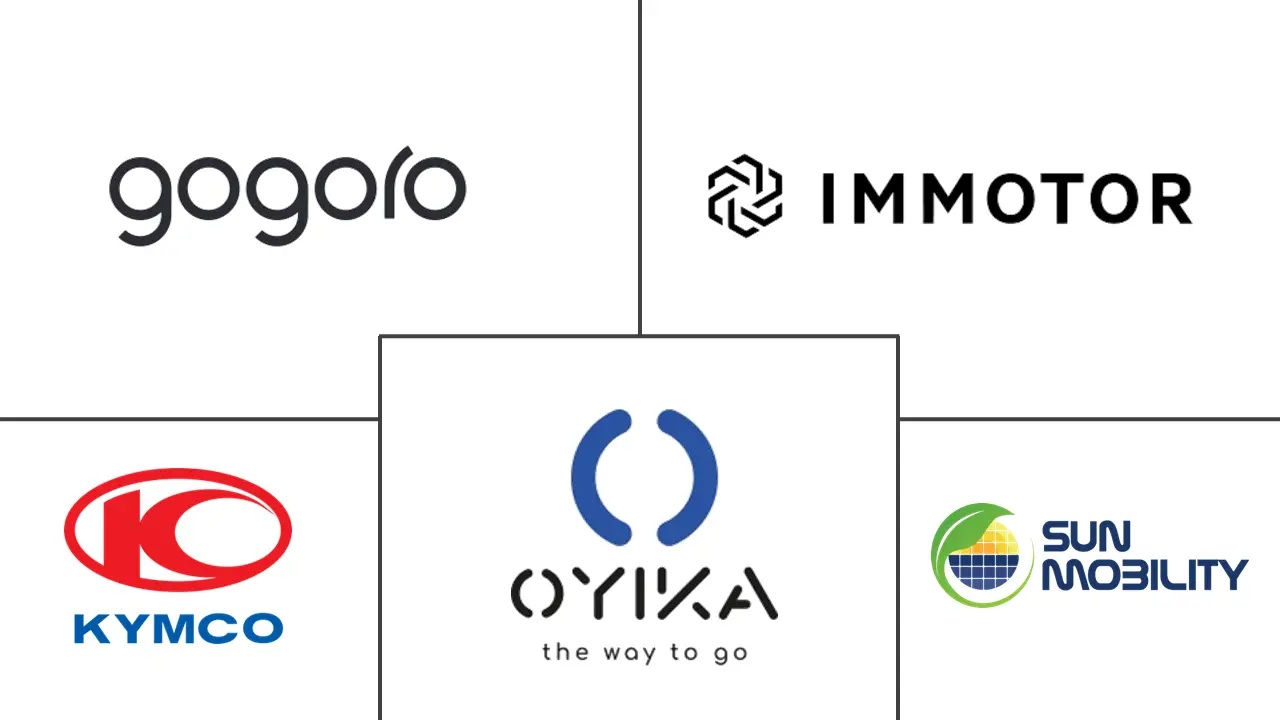Market Size of Battery-Swapping For Electric Two-Wheeler Industry

| Study Period | 2019 - 2029 |
| Market Size (2024) | USD 387.58 Million |
| Market Size (2029) | USD 912.15 Million |
| CAGR (2024 - 2029) | 18.67 % |
| Fastest Growing Market | Asia-Pacific |
| Largest Market | Asia-Pacific |
| Market Concentration | Medium |
Major Players
*Disclaimer: Major Players sorted in no particular order |
Market Overview
The Battery-Swapping For Electric Two-Wheeler Market size is estimated at USD 387.58 million in 2024, and is expected to reach USD 912.15 million by 2029, growing at a CAGR of 18.67% during the forecast period (2024-2029).
In the long run, the global rise of electric two-wheelers, advancements in battery technology, and their increasing use in delivery and ride-hailing services are pivotal drivers for the battery-swapping market. Battery swapping allows consumers to quickly exchange a depleted battery for a fully charged one, often at a reduced cost. This saves money and significantly cuts down on time, a crucial factor for riders in delivery and ride-hailing services who need quick charging solutions.
- In December 2023, Amazon rolled out electric cargo bikes in Croydon, UK, aiming to curb carbon emissions and ease the city's traffic woes. The retail giant has earmarked a substantial investment of GBP 300 million (USD 383.1 million) by 2028, championing the shift to clean energy vehicles for its UK delivery fleet.
As global carbon emissions rise, governments are crafting policies to boost electric two-wheeler adoption. This push is bolstering the battery-swapping market for these vehicles. Recognizing the potential, manufacturers like Yamaha are investing significantly into launching battery-swapping ventures to meet consumer demand. Yet, the industry grapples with challenges: the steep costs of setting up and maintaining battery swapping stations and the absence of standardization among two-wheeler batteries. This lack of uniformity hampers riders' ability to swap batteries at various stations.
- India's Ministry of Road Transport and Highways highlights that Delhi, Uttar Pradesh, and Haryana lead in retail outlets for oil marketing companies (OMC) equipped with battery swapping stations. In 2022, Delhi topped the list with 12 stations, followed by Uttar Pradesh's eight and Haryana's seven.
The battery-swapping market for electric two-wheelers is poised for growth, fueled by the global pivot towards new energy vehicles for daily commutes and cargo transport. Nations like India, Vietnam, and China are at the forefront, with numerous service providers launching battery-swapping initiatives to draw in consumers. Since e-two-wheelers are more affordable than electric passenger cars, they cater well to middle-income consumers, especially in Asia-Pacific.
Scope of the Report
Battery swapping for electric two-wheelers is a technology that allows the replacement of a discharged battery pack with a fully charged pack without the need to wait, as in the case of charging stations. The process of battery swapping is comparatively advantageous for consumers since it is less time-consuming and also attracts a lower price compared to replacing a battery.
The battery-swapping for electric two-wheelers market is segmented by service type, battery type, station type, battery capacity, two-wheeler type, and geography. By service type, the market is segmented into pay-per-use model and subscription model. By battery type, the market is segmented into lithium-ion batteries and lead-acid batteries. By station type, the market is segmented into manual and automated. By battery capacity, the market is segmented into up to 1.5 kWh, 1.6 to 3 kWh, and more than 3 kWh. By two-wheeler type, the market is segmented into e-scooters/mopeds and e-motorcycles. By geography, the market is segmented into North America, Europe, Asia-Pacific, and Rest of the World.
The report offers market sizes and forecasts for battery swapping in value (USD) for all the above segments.
| By Service Type | |
| Pay-Per-Use Model | |
| Subscription Model |
| By Battery Type | |
| Lithium-ion Battery | |
| Lead-acid Battery |
| By Station Type | |
| Manual | |
| Automated |
| By Battery Capacity | |
| Up to 1.5 kWh | |
| 1.6 to 3 kWh | |
| More than 3 kWh |
| By Two-Wheeler Type | |
| E-Scooters/Mopeds | |
| E-Motorcycles |
| By Geography | ||||||||
| ||||||||
| ||||||||
| ||||||||
|
Battery-Swapping For Electric Two-Wheeler Market Size Summary
The battery-swapping market for electric two-wheelers is poised for significant growth, driven by technological advancements and increasing adoption of electric vehicles (EVs) worldwide. The market is experiencing a shift from traditional charging methods to battery swapping solutions, which offer quicker and more efficient alternatives to address range anxiety and lengthy charging times. This transition is supported by the growing demand for electric two-wheelers, particularly in the Asia-Pacific region, where countries like China and India are leading the charge. The market is further bolstered by government initiatives and policies promoting the use of lithium-ion batteries and the development of battery swapping infrastructure. Key players in the industry are expanding their global presence and investing in new technologies to meet the rising demand and enhance their competitive edge.
The market landscape is moderately fragmented, with numerous startups and established companies like Gogoro Inc., NIO Technologies, and Oyika Pte. Ltd. actively participating in the expansion of battery swapping solutions. These companies are forming strategic partnerships and collaborations to develop sustainable energy ecosystems and improve battery technology. The adoption of battery swapping is also gaining traction in Europe, driven by the increasing use of electric two-wheelers for logistics and delivery activities. Despite challenges such as the high cost and limited availability of lithium-ion batteries, the market is expected to grow steadily as advancements in battery technology continue to reduce costs and improve efficiency. The focus on developing a robust battery swapping infrastructure presents a promising opportunity for the industry, facilitating the broader adoption of electric vehicles and contributing to the transition towards sustainable transportation solutions.
Battery-Swapping For Electric Two-Wheeler Market Size - Table of Contents
-
1. MARKET DYNAMICS
-
1.1 Market Drivers
-
1.1.1 Government's Aggressive Focus to Decarbonize the Transportation Industry Fosters the Growth of the Market
-
-
1.2 Market Restraints
-
1.2.1 High Installation Cost of Battery Swapping Stations Deters Market Growth
-
-
1.3 Industry Attractiveness - Porter's Five Forces Analysis
-
1.3.1 Threat of New Entrants
-
1.3.2 Bargaining Power of Buyers/Consumers
-
1.3.3 Bargaining Power of Suppliers
-
1.3.4 Threat of Substitute Products
-
1.3.5 Intensity of Competitive Rivalry
-
-
-
2. MARKET SEGMENTATION (Market Size in Value - USD)
-
2.1 By Service Type
-
2.1.1 Pay-Per-Use Model
-
2.1.2 Subscription Model
-
-
2.2 By Battery Type
-
2.2.1 Lithium-ion Battery
-
2.2.2 Lead-acid Battery
-
-
2.3 By Station Type
-
2.3.1 Manual
-
2.3.2 Automated
-
-
2.4 By Battery Capacity
-
2.4.1 Up to 1.5 kWh
-
2.4.2 1.6 to 3 kWh
-
2.4.3 More than 3 kWh
-
-
2.5 By Two-Wheeler Type
-
2.5.1 E-Scooters/Mopeds
-
2.5.2 E-Motorcycles
-
-
2.6 By Geography
-
2.6.1 North America
-
2.6.1.1 United States
-
2.6.1.2 Canada
-
2.6.1.3 Rest of North America
-
-
2.6.2 Europe
-
2.6.2.1 Germany
-
2.6.2.2 United Kingdom
-
2.6.2.3 France
-
2.6.2.4 Italy
-
2.6.2.5 Spain
-
2.6.2.6 Rest of Europe
-
-
2.6.3 Asia-Pacific
-
2.6.3.1 China
-
2.6.3.2 India
-
2.6.3.3 Japan
-
2.6.3.4 South Korea
-
2.6.3.5 Rest of Asia-Pacific
-
-
2.6.4 Rest of the World
-
2.6.4.1 South America
-
2.6.4.2 Middle East and Africa
-
-
-
Battery-Swapping For Electric Two-Wheeler Market Size FAQs
How big is the Battery-Swapping For Electric Two-Wheeler Market?
The Battery-Swapping For Electric Two-Wheeler Market size is expected to reach USD 387.58 million in 2024 and grow at a CAGR of 18.67% to reach USD 912.15 million by 2029.
What is the current Battery-Swapping For Electric Two-Wheeler Market size?
In 2024, the Battery-Swapping For Electric Two-Wheeler Market size is expected to reach USD 387.58 million.

